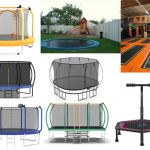- 1-understanding-the-benefits-of-a-mini-trampoline
- 2-essential-materials-and-tools-for-your-diy-mini-trampoline
- 3-step-by-step-guide-to-building-your-mini-trampoline
- 4-safety-considerations-and-maintenance-tips
- 5-real-life-experiences-and-trampoline-zone-recommendations
1. Understanding the Benefits of a Mini Trampoline
Building a DIY mini trampoline at home offers a versatile fitness tool that combines fun and exercise. Mini trampolines, also known as rebounders, provide low-impact cardiovascular workouts, improve balance, and help relieve stress. Having one at home makes it convenient to incorporate physical activity into your daily routine without needing a gym membership.
Whether you want to bounce for fitness, relaxation, or play, creating your own mini trampoline allows customization of size and features to fit your space and needs.
Why Choose a DIY Approach?
Constructing your own trampoline can be a rewarding project that saves money and allows you to personalize materials and design. It also deepens your understanding of how trampolines function, encouraging safer and more mindful use.
2. Essential Materials and Tools for Your DIY Mini Trampoline
Before starting, gather the necessary components and tools to ensure a smooth building process. Key materials typically include:
Materials
- Strong yet flexible trampoline mat or fabric
- Durable metal or PVC frame for support
- High-quality springs or elastic bands for bounce
- Protective padding for safety around the frame
Tools
- Measuring tape and marker
- Drill and screws (if using metal frame)
- Wrenches or pliers for spring attachment
- Scissors or cutting tools for fabric
Ensuring all materials are sturdy and appropriate for weight and usage will contribute to a safe and durable trampoline.
3. Step-by-Step Guide to Building Your Mini Trampoline
Follow these steps to construct your DIY mini trampoline:
Step 1: Design and Measurement
Decide the trampoline size based on available space and intended use. Common mini trampolines range from 36 to 48 inches in diameter. Sketch your design, noting frame dimensions and placement of springs or elastics.
Step 2: Assemble the Frame
Using metal tubing or sturdy PVC pipes, build the circular frame. Secure joints firmly with screws or connectors. Ensure the frame is level and stable to prevent wobbling.
Step 3: Attach the Mat
Cut the trampoline mat to size, allowing extra for attachment points. Evenly space holes around the mat’s edge to attach springs or elastic bands. Carefully connect the mat to the frame tensioners, ensuring uniform tension for consistent bounce.
Step 4: Add Protective Padding
Cover the frame and spring area with thick padding to avoid injuries. Secure the padding tightly with straps or Velcro for safety during use.
Step 5: Test and Adjust
Before use, gently test the trampoline by applying weight gradually. Check for any loose springs or unstable parts. Adjust tension or tighten screws as needed.
4. Safety Considerations and Maintenance Tips
Safety is paramount when building and using a mini trampoline. Follow these precautions:
Proper Assembly
Double-check all connections and attachments. Faulty assembly can lead to accidents.
Use on Flat Surfaces
Place your trampoline on a flat, non-slip surface indoors or outdoors to prevent tipping.
Regular Inspection
Inspect springs, frame, and padding regularly for wear and tear. Replace damaged parts promptly.
Limit Usage
Adhere to recommended weight limits and avoid risky moves to ensure longevity and safety.
5. Real-Life Experiences and Trampoline Zone Recommendations
Jessica, a fitness enthusiast, shared how building her own mini trampoline at home boosted her motivation to exercise daily. She customized her trampoline to fit her small apartment and appreciated the savings compared to commercial models.
Mark, a parent, constructed a mini trampoline for his kids, adding colorful padding and interactive decals, making bouncing a fun family activity that encourages physical health.
For those seeking quality materials or ready-made options, Trampoline Zone offers a wide range of trampolines and accessories. Whether building from scratch or enhancing your project, their trusted products ensure durability and safety.
Building a DIY mini trampoline at home is a fulfilling project that combines creativity, fitness, and fun. With the right materials, careful assembly, and safety measures, you can enjoy a personalized trampoline that meets your family’s needs perfectly.







 Zap Zone XL4.0 (2483 reviews)
Zap Zone XL4.0 (2483 reviews) We Rock the Spectrum - Northeast Philly4.0 (190 reviews)
We Rock the Spectrum - Northeast Philly4.0 (190 reviews) Westbank Village Shopping Center4.0 (539 reviews)
Westbank Village Shopping Center4.0 (539 reviews) Super Sky High Bungee5.0 (1 reviews)
Super Sky High Bungee5.0 (1 reviews) Boomers Santa Maria4.0 (1904 reviews)
Boomers Santa Maria4.0 (1904 reviews) Get Air Pickerington4.0 (651 reviews)
Get Air Pickerington4.0 (651 reviews) Are Trampoline Parks Safe for Kids? Essential Guide for U.S. Parents
Are Trampoline Parks Safe for Kids? Essential Guide for U.S. Parents How Often Should You Replace Trampoline Springs? Tips for Proper Maintenance
How Often Should You Replace Trampoline Springs? Tips for Proper Maintenance How Much Is a Trampoline? A Detailed Guide to Trampoline Costs and Buying Tips
How Much Is a Trampoline? A Detailed Guide to Trampoline Costs and Buying Tips Bounce Techniques for Stronger Legs: Effective Exercises and Tips
Bounce Techniques for Stronger Legs: Effective Exercises and Tips Essential Music Gear for Trampoline Dance: Complete Guide
Essential Music Gear for Trampoline Dance: Complete Guide Fun STEM Experiments Using Trampolines to Spark Curiosity and Learning
Fun STEM Experiments Using Trampolines to Spark Curiosity and Learning